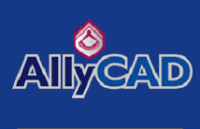Description

AllyCAD

BricsCAD
Comprehensive Overview: AllyCAD vs BricsCAD
AllyCAD and BricsCAD are both computer-aided design (CAD) software products, but they cater to different markets and have some distinct features. Here’s a comprehensive overview of each:
a) Primary Functions and Target Markets
AllyCAD:
-
Primary Functions:
- AllyCAD is a 2D and 3D CAD software primarily used for engineering and architectural design. It offers functionalities such as drafting, modeling, and design tools that are tailored for infrastructural projects.
- The software is equipped with specialized options for civil engineering, survey work, and structural design.
- It integrates well with road design and site development processes, providing easy-to-use shortcuts and templates.
-
Target Markets:
- AllyCAD is predominantly focused on the civil engineering sector, including roads, drainage, and urban development.
- It is popular among engineering firms, municipalities, and government agencies that require specific tools for infrastructure and civil works.
BricsCAD:
-
Primary Functions:
- BricsCAD is a versatile CAD platform supporting both 2D drafting and 3D modeling, geared towards various engineering disciplines.
- It offers a suite of features comparable to AutoCAD for a range of industries, including mechanical, architectural, civil, and more.
- It provides detailed BIM (Building Information Modeling) capabilities and sheet metal design functionalities.
-
Target Markets:
- BricsCAD targets a broader market inclusive of architects, mechanical engineers, and construction professionals.
- It's used worldwide by businesses that need comprehensive CAD solutions at a more competitive price point compared to traditional industry leaders like AutoCAD.
b) Market Share and User Base
-
AllyCAD:
- AllyCAD is more regionally focused with a stronger presence in South Africa and nearby regions, given its origin and development targeted at local engineering needs. Its market share is smaller globally due to its specific focus.
- The user base consists mainly of civil engineers and public works departments who need tailor-made tools for local infrastructure projects.
-
BricsCAD:
- BricsCAD holds a larger global market share compared to AllyCAD. It is considered a substantial competitor in the CAD market, especially for those looking for an alternative to AutoCAD.
- Its user base is diverse, spanning industries such as architecture, engineering, and construction on a global scale. It has steadily grown its presence through strategic pricing and robust features.
c) Key Differentiating Factors
-
Specialization vs. Versatility:
- AllyCAD is specialized for civil engineering and infrastructural design, offering tools uniquely suited for these areas, such as roadworks and survey integration.
- BricsCAD, by contrast, is versatile and approaches design with broader capabilities suitable for multiple industries such as architecture, mechanical engineering, and BIM applications.
-
Geographic Focus:
- AllyCAD has a stronger foothold in specific regions, focusing on localized engineering and infrastructural needs.
- BricsCAD has a global outreach with features that cater to international standards and practices.
-
Pricing and Cost:
- AllyCAD typically provides cost-effective solutions for engineers who need specific features without excess options they won't use.
- BricsCAD offers competitive pricing compared to AutoCAD, appealing to businesses seeking a lower-cost alternative without sacrificing functionality.
-
Integration and Add-ons:
- AllyCAD includes specific features and plugins for civil engineering out of the box, making it attractive for such tasks without the need for additional purchases.
- BricsCAD supports numerous third-party applications and extensions, allowing customization and expansion into various specialized applications through its open API.
In summary, while both AllyCAD and BricsCAD are valuable tools within the CAD industry, they serve different niches and offer distinct advantages to their users. AllyCAD is particularly beneficial for those focused on civil engineering, whereas BricsCAD caters to a broader CAD audience seeking a versatile and cost-effective alternative.
Contact Info

Year founded :
Not Available
Not Available
Not Available
Not Available
Not Available

Year founded :
Not Available
Not Available
Not Available
Not Available
http://www.linkedin.com/company/bricscad
Feature Similarity Breakdown: AllyCAD, BricsCAD
Here’s a breakdown of the features and similarities between AllyCAD and BricsCAD:
a) Core Features in Common
-
2D Drafting: Both AllyCAD and BricsCAD offer robust 2D drafting capabilities, suitable for creating precise engineering and architectural drawings.
-
3D Modeling: Each software provides 3D modeling functionalities, allowing users to work on complex 3D designs.
-
Interoperability: They support a wide range of file formats, facilitating interoperability with other CAD systems. Common formats include DWG and DXF, among others.
-
Customization and Scripting: Both platforms offer customization options through APIs and scripting languages (like LISP), allowing users to automate tasks and create custom tools.
-
Layer Management: Advanced layer management tools are available in both, enabling users to organize and control different aspects of their projects.
-
Annotation and Dimensioning: These features let users add necessary annotations and dimensions to their drawings for better clarity and communication.
b) User Interface Comparison
-
AllyCAD: Known for its intuitive and user-friendly interface, AllyCAD focuses on simplicity and ease of navigation. Its design caters predominantly to civil engineering and related fields, emphasizing workflow efficiency with customizable toolbars and a straightforward layout.
-
BricsCAD: Offers a more traditional CAD interface, similar to AutoCAD, which might appeal to users familiar with such environments. It provides a clean layout with customizable ribbons and panels. It supports both a light and dark theme, accommodating user preferences.
c) Unique Features
-
AllyCAD:
- Road and Stormwater Design: AllyCAD excels in civil engineering tools, particularly with its specialized features for road and stormwater drainage design.
- Surveying Solutions: It offers integrated solutions for survey data processing, which is particularly beneficial for civil engineers.
- Localized for Specific Regions: AllyCAD often incorporates region-specific standards, making it effective for users in certain geographical areas requiring adherence to local engineering standards.
-
BricsCAD:
- AI-based Tools: BricsCAD incorporates AI-based features for enhancing design processes. For instance, its AI functions can optimize 3D models and suggest modifications for improved efficiency.
- BIM Integration: BricsCAD provides significant Building Information Modeling (BIM) capabilities, offering a comprehensive BIM workflow within its environment.
- Mechanical Design Suite: The software includes a mechanical design suite for users involved in mechanical modeling and design, enhancing its versatility across different fields of engineering.
- Cloud Connectivity: BricsCAD includes features for cloud connectivity, enabling easier collaboration on projects and remote access to files.
In summary, while both AllyCAD and BricsCAD share fundamental CAD functionalities, their differences lie in specialty functionalities and target user segments, with AllyCAD focusing on civil engineering-specific tools and BricsCAD offering advanced modeling capabilities alongside BIM and AI tools.
Features

File Compatibility
Customization and Integration
User-Friendly Design Interface
Design and Drafting
Support and Learning
Collaboration Features
Project Management
Advanced Drawing Tools
Customer Support Resources
Collaboration and Sharing

Flexible 2D and 3D Design
Efficient Collaboration Tools
Customization and Compatibility
Collaboration and Sharing
User-friendly Interface
Advanced Features for Professionals
Customization and Extensions
Intuitive Design Tools
Best Fit Use Cases: AllyCAD, BricsCAD
When considering AllyCAD and BricsCAD, it's important to understand the particular strengths and design philosophies behind each CAD software, as well as how these align with various business needs and industry requirements. Both have distinctive attributes that make them suitable for different scenarios.
a) For what types of businesses or projects is AllyCAD the best choice?
AllyCAD:
-
Civil Engineering Projects:
- Specialization: AllyCAD is particularly well-suited for civil engineering projects. It offers extensive tools for road design, terrain modeling, and other civil infrastructure projects, making it a preferred choice for businesses focusing on civil planning and construction.
-
Small to Medium Enterprises (SMEs):
- Budget-Friendly: Its pricing model is often more accessible for small to medium-sized enterprises that require robust design tools without the heavy investment associated with larger CAD systems.
-
Local Government Projects:
- Regulatory Compliance: AllyCAD is popular in certain regions (notably in South Africa) due to its alignment with local regulatory standards and practices in engineering, making it ideal for projects that need to adhere strictly to regional compliance.
-
Education and Training:
- Ease of Learning: Given its focus on user-friendly interface and tools, it can be a good option for educational institutions and training centers aiming to equip students with practical design skills without overwhelming complexity.
b) In what scenarios would BricsCAD be the preferred option?
BricsCAD:
-
Architecture and Construction:
- BIM Capabilities: BricsCAD offers strong Building Information Modeling (BIM) capabilities, making it ideal for architecture and construction firms that require detailed modeling and property enrichment, supporting visualization, quantity takeoffs, and project documentation.
-
Mechanical Design and Manufacturing:
- 3D Direct Modeling: It provides powerful tools for mechanical design and engineering, including 3D direct modeling features and support for assembly design, which are beneficial for manufacturing firms focused on product design.
-
Large Enterprises and Global Teams:
- Cross-Platform Compatibility: BricsCAD's compatibility with DWG files and its strong performances on various operating systems (Windows, macOS, Linux) make it suitable for large enterprises with diverse teams accessing files across different platforms and requiring interoperability with other CAD software.
-
Geospatial Projects:
- Advanced Tools: Its integration of geospatial tools appeals to businesses engaged in urban planning and geospatial analysis, offering advanced mapping and data analysis capabilities.
d) How do these products cater to different industry verticals or company sizes?
AllyCAD:
- Industry Focus: Primarily beams towards civil engineering, infrastructure design, and localized industries requiring adherence to specific regional standards. It's a strong contender in sectors that do not demand extensive 3D modeling or international file format integration.
- Company Size: More approachable for small to medium-sized businesses and specialized firms due to its cost-effectiveness and concentrated feature set.
BricsCAD:
- Industry Focus: Serves a broad range of industries including architecture, construction, mechanical design, and geospatial analysis. Its support for advanced BIM features and mechanical design tools caters to diverse engineering and design sectors.
- Company Size: Suitable for both small businesses—offering professional-grade tools at a competitive price—and large enterprises that require scalability, robust features, and cross-platform solutions.
In summary, the choice between AllyCAD and BricsCAD largely depends on the technical requirements of the project, industry standards, budget constraints, and the existing ecosystem within the business or project environment.
Pricing

Pricing Not Available

Pricing Not Available
Metrics History
Metrics History
Comparing undefined across companies
Conclusion & Final Verdict: AllyCAD vs BricsCAD
Conclusion and Final Verdict for AllyCAD vs. BricsCAD
When choosing between AllyCAD and BricsCAD, it's essential to evaluate your specific needs, budget, and the types of projects you'll be working on. Both software packages offer unique strengths and some drawbacks, which may make one more suitable than the other for your requirements.
a) Considering all factors, which product offers the best overall value?
BricsCAD tends to offer the best overall value, particularly for users who need a versatile, powerful, and feature-rich platform that can handle a wide range of design and drafting tasks. Its compatibility with other CAD programs and its strong 3D modeling capabilities make it an attractive option for many professionals. Additionally, BricsCAD's pricing structure can be more affordable over time for businesses considering the perpetual license options.
b) Pros and Cons of Choosing Each Product
AllyCAD:
-
Pros:
- User-friendly interface which can be appealing for beginners.
- Tailored towards civil engineering and infrastructure projects.
- Strong local support, particularly beneficial for users in South Africa.
- Good 2D drafting capabilities and fast, efficient performance for those specific tasks.
-
Cons:
- Limited 3D modeling capabilities compared to BricsCAD.
- Smaller user community, which can impact the availability of tutorials and forums.
- Fewer updates and features, leading to potential scalability issues for growing companies.
BricsCAD:
-
Pros:
- Strong 3D modeling capabilities, including BIM functionalities.
- Highly compatible with DWG files and other CAD software, easing collaboration.
- Offers a choice of licensing options, including perpetual licenses, which can be cost-effective.
- Active development with regular updates and new feature releases.
-
Cons:
- May have a steeper learning curve, particularly for beginners.
- Requires more robust hardware to take full advantage of its features.
- Potentially more expensive upfront compared to AllyCAD.
c) Specific Recommendations for Users
-
For Beginners and Small Businesses:
- Consider AllyCAD if your primary focus is on 2D drafting and you operate within sectors like civil engineering where the software's strengths shine. Its ease of use and learning curve are advantageous for those with limited CAD experience.
-
For Versatile and Growing Needs:
- Choose BricsCAD if you anticipate needing a robust 3D modeling capability or if you work on a variety of projects that require different CAD functionalities. Its compatibility and feature set make it a solid choice for firms looking for scalability and integration with other design tools.
-
Budget Constraints:
- Evaluate the long-term costs and benefits of perpetual licensing offered by BricsCAD, which can be more cost-effective over time when compared to subscription models.
In conclusion, while both AllyCAD and BricsCAD have their merits, the best choice largely depends on your particular needs, project requirements, and budget constraints. Assessing these factors carefully will guide you toward the most suitable solution.
Add to compare
Add similar companies




